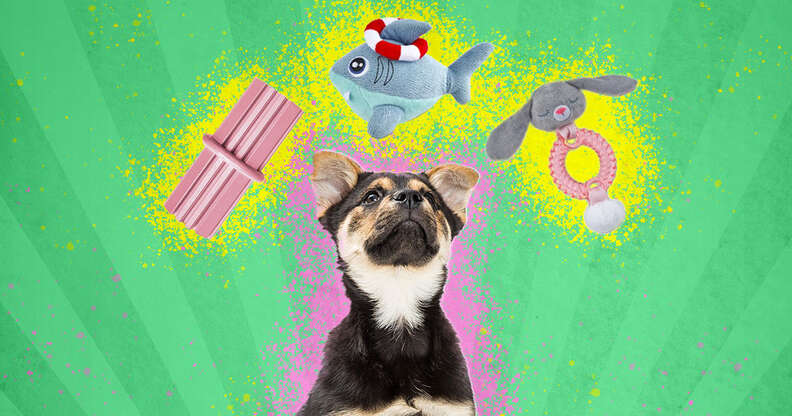How To Help Your Teething Puppy (And Save Your Furniture)
And your fingers 😬

Is your puppy teething? If you have bite marks on your furniture legs (or your own legs), then the answer is probably yes.
The teething process is painful and can cause your puppy to chew and gnaw on whatever will stop her teeth from hurting — and while you can’t really blame her, you can help her.
And even though it’s impossible to skip right over the teething process, there are ways to help ease your puppy’s pain and save your furniture.
The Dodo talked to three veterinarians to find out what exactly teething is, what to know and look for when your puppy starts teething, and how exactly you can help soothe the soreness.
What is teething and when do puppies start teething?
Teething is the process of growing new teeth, and it happens to puppies and humans alike.
“Puppies start getting their first set of teeth around 2 weeks,” Boulder, Colorado-based holistic veterinarian Dr. Angie Krause told The Dodo, and this is when the teething symptoms (like biting and chewing!) begin. This first set of 28 teeth are called deciduous teeth, meaning they’ll fall out to make room for a second set. The deciduous teeth finish erupting around week 6.
Dr. Krause explained that the second set of 42 teeth generally grows in at about 6 months of age.
However, “there is a lot of variability between breeds,” Dr. Donnell Hansen, a veterinarian specializing in dentistry and oral surgery at BluePearl Specialty and Emergency Pet Hospital, told The Dodo. “So, we tend not to get too worried about exactly WHEN each tooth erupts, but we like to be sure the general trend is that all the teeth are appearing around 4 to 6 months of age.”
When do puppies lose their baby teeth?
Just like human kids, puppies lose their first set of teeth and begin to grow their second “adult” set soon after. “Puppies lose their baby teeth starting at 3 to 4 months of age,” Dr. Krause said.
Puppy teething symptoms
When your puppy’s teeth start coming in, you might notice some tell-tale signs:
- Drooling. And not just during dinnertime.
- Bleeding. If you notice spots of blood on your puppy’s toys, then she’s likely going through the teething process.
- Tiny teeth on your floor or in your bed! Kind of cute. Kind of creepy. But totally normal. A lot of times, puppies will end up ingesting their baby teeth while eating, so it’s also normal to not find baby teeth, too.
- Chewing (like … LOTS of chewing). “Puppies tend to mouth and chew their people and anything else they can find!” Dr. Krause said. This includes your hands, too, so beware!
How to help a teething puppy
While you don’t want to make your puppy feel bad — she’s in a lot of pain, after all! — you still want to keep your household (and yourself!) intact. Here are a few ways you can help your teething puppy get through the soreness and instinct to chew anything and everything.
Give her plenty of puppy chew toys.
“Just like in humans, puppies will often feel more comfortable when chewing as they are teething, and chewing is also a way they explore and learn about their environment,” Dr. Jessica Romine, a veterinarian at BluePearl Specialty and Emergency Pet Hospital, told The Dodo. Rubber toys are best, and your puppy may enjoy rubber toys with different textures.
Avoid toys that are too hard (or too soft!).
“Avoid anything harder than a tooth itself (so things like antlers, bones, etc.) as this can lead to tooth chipping and fracturing,” Dr. Romine advised. “Some people may mention frozen dishrags, like [are used] for babies, but I would be careful there because it will thaw and may be tempting to a puppy to tear up and swallow!”
Freeze some yummy treats.
“For extra pain relief, you can freeze baby food (ensure there are no onions in the formula) in a KONG or Toppl,” Dr. Krause suggested. Frozen carrots are a good option, too. The cold will really help knock down the soreness of your puppy’s gums.
Don’t yell or punish her for chewing on something she’s not supposed to.
Your puppy’s already going through it, so be as gentle as possible. Yelling and punishing is never the route you should take when training a puppy. Instead, “redirect puppies to healthy chew toys,” Dr. Krause said.
When do puppies stop teething?
A puppy will stop teething once all her baby teeth fall out and her adult teeth are fully formed, which usually happens around 6 to 8 months old — but the puppy teething timeline will be different for every puppy.
Make sure to check on your puppy’s teething progress to see if they’re coming in right — and to ensure that no baby teeth are still hanging around.
“Perhaps most important about teething is to seek care if you ever see a fractured tooth, discolored tooth or teeth hitting the wrong place (like growing in on top of each other or sticking out in weird ways),” Dr. Hansen advised.
After around 6 to 8 months, your puppy should have all of her 42 adult teeth, and the puppy teething phase will — thankfully — be over.
We independently pick all the products we recommend because we love them and think you will too. If you buy a product from a link on our site, we may earn a commission.